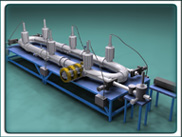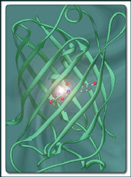
In the group we study the physical and photo physical properties of molecular systems. Most of our work is related to molecules and their ions in vacuum - that is in an environment where the intrinsic properties of the systems may be determined. One of our main goals is to find and describe the mechanisms that tunes the absorption wavelength of molecules when they are found in proteins. Indeed, color vision is based on specific atomic-scale perturbations. The project is done in close collaboration with laboratories where special molecular 'antennas' are designed and with theoretical groups worldwide.
Our research is of interest from a basic point of view, yet many processes that are being studied are also interesting for applications, e.g. radiation damage of biomolecules, in our understanding of astrophysics, and the physics of atmospheres and plasmas. Excited-state properties are also important for new quantum technologies.
Animation of experiment at ELISA
Detailed knowledge of atomic processes within biomolecules such as proteins is clearly hard to obtain due to the many and complicated interactions that are involved. We use absorption spectroscopy to probe interactions in biomolecules at the atomic level, since, as is well known, the electronic structure, and hence the absorption of molecules, depends on the chemical environment of the molecule. Thus, we have initiated a research program, where photon absorption of chromophores is studied under different conditions: in the gas phase, in solvents, and in proteins.
One of the aims of our studies is to gain information about perturbations in proteins and we are synthesizing new chromophore molecules to study the dependence of such interactions on the structure of the chromophore. The fact that we are able to make new molecules and study their intrinsic properties may have applications for developments of new photo-sensing proteins. We are studing the effect of solvents in a stepwise manner by adding one molecule at the time to the chromophore and gradually make a transition from the gas phase to the liquid phase.

Our initial studies of chromophores of the Green Fluorescent Protein (GFP) showed the striking result that the chromophore environment in the protein may be closer to vacuum than to that of solvents. Later chromophores of many other photoactive proteins like PYP, DsRed and Rhodopsin have been studied. We have collected good evidence that the interior of these proteins is far from being solution like - rather, the chromophores sit in a vacuum-like environment. At the moment, much efforts are concerned with an investigation on the specific mechanisms that make color tuning possible in the visual pigment proteins in the eye. |
At SAPHIRA, we specifically conduct time-dependent photo detachment and photo dissociation studies. Here we use pulsed lasers to liberate electrons from accelerated anions and to create molecular fragments. Nano- and femtosecond lasers are available. We obtain electronic binding energies in deprotonated bio-chromophores with the setup and learn about the way energy is being shared between nuclear and electronic motions. We follow excited-state dynamics, like isomerization, in gas-phase in real time with fs-laser pump-probe techniques. The ion-storage ring SAPHIRA is used for this purpose where molecular ions are stored under vacuum conditions and exposed to laser excitation. Prior to storage in the ring the molecular ions are cooled to 6 K.